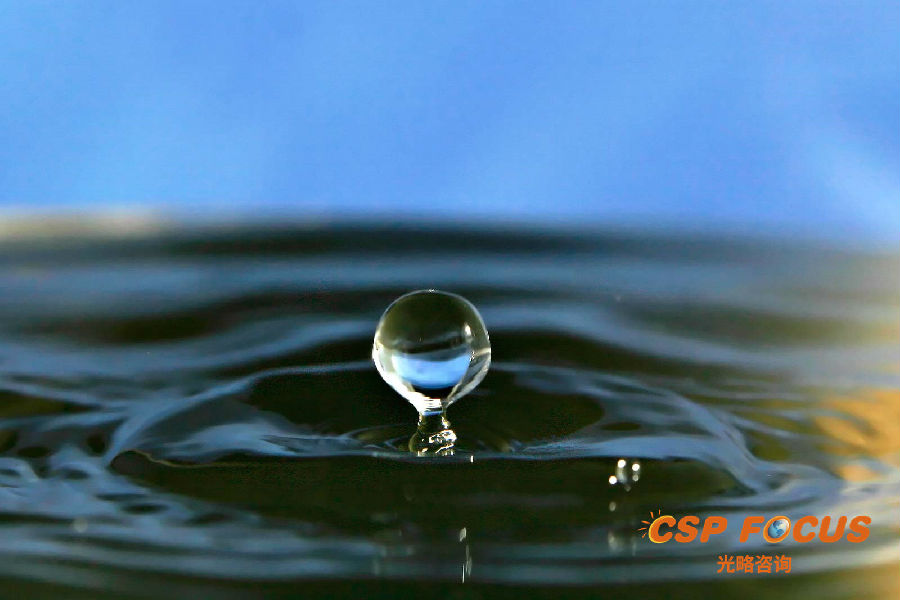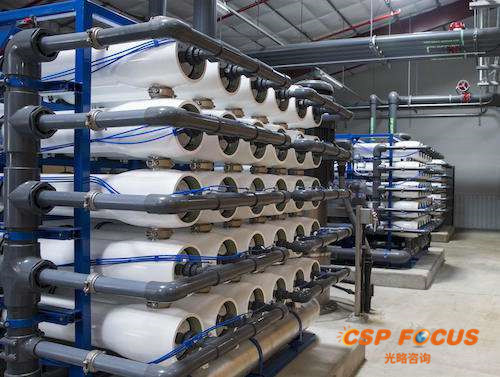Home > Market > Other Regions > Here
The challenges and potential rewards of transitioning to concentrated solar power to desalinate seawater
2018.05.23 From: SolarPACES
Freshwater shortages are projected to increase in our hotter and more crowded future. Already, 150 countries desalinate seawater, using fossil fuels.

But supplying an ever-increasing basic need with non-renewable fuels creates a growing threat, according to Dr. Diego-César Alarcón-Padilla, who heads up SolarPACES Task VI at the Solar Desalination Unit at Plataforma Solar de Almería (PSA).
“Today there is no large capacity desalination plant that is working using renewables” said Dr. Alarcón-Padilla. “There is none.”
“With desalination we introduce a new consumer of energy. With climate change, and the increase of the human population, and the contamination of the current water resources, year after year we need more and more freshwater,” he said.
“Desalination needs energy. And today we are already in the limit in the use of fossil sources, just for recurring demand. If we are serious about meeting our Paris commitments keeping the temperature of the planet to the 2°C rise, we must desalinate with clean energy.”
With 16,000 desalination plants around the world already and an expected 15% rise in desalination as the world warms, a policy to drive solar desalination is needed. Dr. Alarcón-Padilla believes that the desalination industry won’t change without a policy driver.
Learn from renewable policies
It took legislation to first put new renewables like solar and wind onto electric grids. Regulators began requiring generators to include renewable energy in the early 21st century. Mandates and subsidies jumpstarted the transition.
To now develop renewable desalination, Dr. Alarcón-Padilla proposes the adoption of similar policies. “We need something like a premium per cubic meter of water produced by this solar desalination plant, or a guarantee from the state that they are going to purchase each cubic meter of “clean” water that is required by the public. Just like we had a feed in tariff for electricity produced by renewable energy plants here in Spain.”
At current prices, and depending on regional differences, he estimates that CSP (concentrated solar power) could deliver fresh water from Reverse Osmosis desalination at around 80 cents USD per cubic meter—about 30 cents more than fossil fueled desalination.
Once policy drove it, renewable projects were deployed and supply chains developed. Renewable prices dropped. Now, many regulators have set targets for full decarbonization by 2050. What seemed risky initially turned out to be not so hard. In many regions, solar and wind is now the low price option.
The same could happen in renewable desalination: “Because then we will start to have the experience and learn how to deal with variable solar resources with desalination. Then we would start to have the large capacity solar desalination plants that we need.”
He detailed the challenges and opportunities for a similar transition to 100% solar desalination.

Reverse osmosis. Credit: USMarine Corps Base Camp Pendleton
Why desalination is a conservative industry
Desalination began first in the 1950s in the parched Middle East, with thermal desalination technologies driven by plentiful fossil energy.
“Saudi Arabia and Kuwait and Bahrain; all of their water comes from desalination. They only have water underneath for a few days, so they cannot afford to take any risks,” he explained.
“So you can imagine, this industry is very conservative, where water reserves are very low. The population grows year after year in the Arab countries. And the freshwater resource does not grow: they cannot have the luxury of failure in implementing a desalination plant.”
The Arabian Gulf is an enclosed sea, with no freshwater rivers feeding into it, and high temperatures increase evaporation, further increasing both salinity and temperature.
“There are some places where you can get around 45 or even 50 grams per litre (g/L) of salt. In addition, you can have oil spillage and algae blooms that could cause a failure in the pretreatment system of, for example, a Reverse Osmosis plant,” he said.
Thermal desalination is a proven technology well suited to the harsh conditions in the Gulf, but from an energetic viewpoint is quite inefficient compared to today’s more widespread Reverse Osmosis. But such “difficult” seawater can damage membranes, stopping a Reverse Osmosis plant:”So they’re not going to abandon thermal desalination technologies completely. They want to have both.”
When to combine thermal desalination with CSP
Initially solar thermal energy was proposed as best suited to thermal desalination processes, which essentially use heat to evaporate water. However, the heat for thermal desalination is necessarily located at the site of the desalination plant, which creates a challenge.
“There are two problems with CSP-based cogeneration plants for simultaneous generation of electricity and thermal desalination of seawater: salt air corrosion, and that DNI at the coast is not so good as inland. So there’s a penalty in electricity and fresh water costs. The best option for this scenario is siting the CSP plant inland, away from the saline ambient effects, and the Reverse Osmosis plant at the coast,” he noted.
Electricity for Reverse Osmosis Sesalination can be transmitted from afar, but heat for thermal desalination cannot. So, in this case, CSP seems better paired with Reverse Osmosis, when seawater conditions allow the use of this technology without problems.
For CSP cogeneration plants, thermal desalination is powered by the waste heat available at the outlet of the steam turbine. The feasibility of this option versus the separated production of electricity and desalinated water (using part of that electricity) depends on two factors: the degree of penalty in power production introduced by establishing a higher pressure value for the steam at the outlet of the turbine (required by the thermal distillation plant) and the specific investment cost of the distillation unit.
For example, dry-cooled CSP plants produce water in winter at about 50°C to 60°C in summer, close to the 70°C inlet temperature that thermal desalination units (low-temperature MED) need.
In the last years, a lot of research effort is being done in developing new heat exchange surfaces based on polymeric materials for thermal distillation plants. Such developments can substantially reduce the impact of the investment cost in the final cost of the fresh water.
In the case of standalone solar thermal desalination plants, CSP is the best option to supply the thermal energy a medium temperature required by high-efficient configurations: multi-effect distillation with thermocompression, multi-effect distillation coupled to absorption heat pumps and nanofiltration+multi-effect distillation.
Why CSP is better paired with Reverse Osmosis (RO) desalination
Today’s predominant desalination technology uses a process where only electricity is used, sending power round the clock to pump water through a series of membranes to extract the fresh water through Reverse Osmosis (RO).
“In most of the world, for desalination applications at industrial scale, a CSP plant coupled to an RO plant which uses electricity for the power plant would be a better option than coupling it with thermal desalination,” he noted.
“RO is more efficient when you have what we call “non-difficult” water, like in the Mediterranean Sea, in North Africa, and even in the Red Sea where salinity is a little bit higher,” he said. “For example in the Mediterranean Sea the salinity is only 35 grams per liter (g/L) and you don’t have the problem of changing conditions that could damage the membranes.”
The specific energy consumption depends on the salinity of the water. The higher the salinity the higher the specific energy consumption: “For example, at the top efficiency, here in Spain with around 34 to 35 g/L salinity the typical specific energy consumption that each RO module needs is around 3 kWh per cubic meter of freshwater produced.”
“But the Middle East with higher salinity, 40 to 45 g/L, has higher electricity consumption, because you need a higher pressure, so typically they need up to 4.5 kWh per cubic meter.”
CSP + storage = 100% solar desalination
Alarcón-Padilla contends that the only truly 100% solar desalination is with CSP, due to its ability to supply firm energy for long durations with thermal energy storage (TES). Citing the recently announced Metito plant in Saudi Arabia, reportedly powered by solar PV, he noted that when night falls the plant will switch to grid power.
“For me this is not solar desalination,” he said. “True solar desalination is when you face the challenge of dealing with a variable source of energy like solar. CSP can deliver a very flat profile. It has an advantage due to its dispatchability.”
“In principle PV looks cheaper, but you have the problem of no dispatchability. The energy delivery is not flat. It is variable along the day. In addition PV doesn’t have cheap storage available for large capacity.”
Desalination cannot be turned off when clouds pass, he pointed out. “You can have scaling problems in the membrane if you keep turning it on and off.
As a result, when PV is proposed, it must be backed up to the grid, resulting in much less than 100% solar desalination: “When this “solar” desalination plant is taking electricity from the grid, for me this is just a PV plant that puts electricity into the grid”
The same issue applies to CSP with no storage, of course. At sundown, without stored energy, CSP would also switch to grid power. Storage also helps financially: “You want to keep the RO plant working the maximum number of hours to reduce the impact of the investment cost and the final cost of the water.”
But there’s more than one kind of storage. In addition to CSP’s thermal storage, both it and PV can simply store any of their surplus “spilled solar” in fresh water, increasing profitability.
“Storing energy is very expensive but storing water—just in a normal water tank—is very cheap,” Alarcon-Padilla noted. “When electricity demand is low you can put the desalination modules in operation in order to produce more freshwater.”
Relevant CSP Conference:CSP Focus MENA 2018(June 27-28,Marrakeck Morocco)
More from CSP Focus
NextLeave your thoughts here
Reports(Member Only)
See more+-
CSP Focus Membership Proposals
We are now proposing CSP Focus Membership, hoping to better serve our members to keep pace with the latest updates of ongoing CSP projects worldwide, and to establish and maintain business relations with major shareholders of the projects. CSP Focus offers to Membership exclusive access to:1. Daily/Weekly update and analysis on CSP policies, projects, technologies, market trend and corporate relea
-
The Latest CSP Focus Monthly Update
Join CSP Focus Membership to Get the Latest CSP Focus Monthly Update December Edition.
-
CSP Project Monthly Update 2022 December Edition
CSP Focus is presenting CSP Project (China) Update 2022 December Edition.Detail report is available for CSP Focus Membership.
-
Presentations-CSP Focus China 2021
The Report is for CSP Focus Members only.
Upcoming Events
See more+-
12th CSP Focus China 2022
2022.04.21-22 Beijing
-
11th CSP Focus China 2021
2021.10.28-29 Beijing
-
10th CSP Focus China 2020
2020.10.22-23 Beijing, China
Project Updates
See more+-
Lanzhou Dacheng Dunhuang CSP Project
Asia Pacific-China,Operational,Parabolic Trough
-
Luneng Haixi 50MW Molten Salt Tower CSP Project
Asia Pacific-China,Operational,Power Tower
-
Dubai 950MW NOOR Energy 1 CSP+PV Project
MENA-UAE,Under construction,Power Tower
-
Power China Gonghe 50MW Molten Salt Tower CSP Project
Asia Pacific-China,Operational,Power Tower





